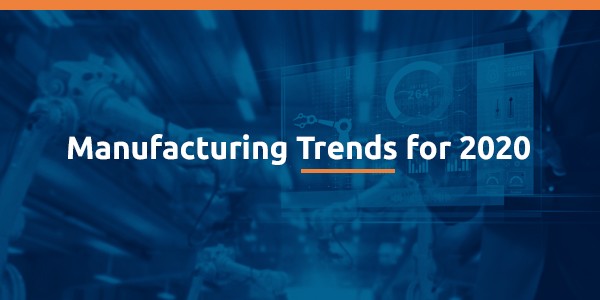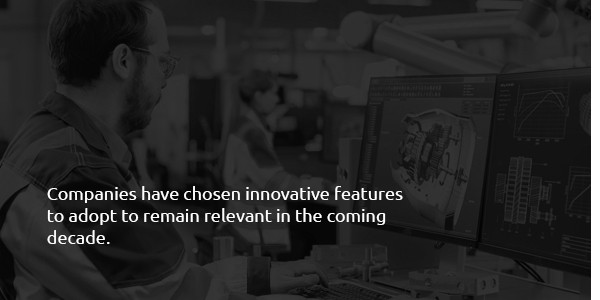Manufacturing Trends for 2020

Table of Contents
1. Augmented Reality
2. Virtual Reality
3. Cybersecurity Concerns
4. 3D Scanning
5. 3D Printing
6. Robotics
7. Mobile Robots
8. Internet of Things
9. Predictive Analytics
10. 5G
What to Expect for the Future
Learn More Insider Tips For the Manufacturing Industry
The future of the manufacturing industry starts with innovations in use today. While many of these trends have yet to achieve universal use throughout the sector, many have improved the operations of the companies that implement them. Integrating any of these trends for 2020 will help your facility to become more productive and efficient if used correctly.
The Latest Manufacturing Trends
In the coming year, manufacturing will more completely embrace the use of computers and machine learning to integrate predictive analysis and the Internet of Things (IoT) into operations. Using these technological innovations won’t completely replace human workers. Instead, these trends will augment the existing staff to help them become more productive and efficient on the job.

1. Augmented Reality
Augmented reality (AR) will become a more important aspect of maintaining safety in the coming years. This technology can allow workers to see the factory floor and an overlay on a digital screen. The display can show safety rules to follow in the area or indicate whether handles are cool enough to touch. For those in chemical manufacturing, they can wear electronic glasses that let them see what they are doing, as well as display a warning if a sensor indicates a dangerous chemical reaction.
The best part of AR technology is that it can use existing technology many facilities already use. If a manufacturer does not want to invest in headsets, employee cell phones or tablets can also perform AR services. Any device with a camera and a display can integrate information on safety features about the surrounding area. Because this form of safety reminder can use existing technology, it does not require an investment into new equipment to take advantage of it.
Other possible uses of AR include on-the-job training and giving directions for making repairs or maintenance services. Like the related technology of virtual reality (VR), AR relies on having human workers. AR and VR both help people to become better at their jobs by offering real-time, on-site training as needed.
2. Virtual Reality
Experts predict that one in three manufacturers will integrate either VR or AR into their practices in the next three years or have done so already. The increase in the use of this technology likely comes from innovations that make it cheaper and more readily available today than in the past.
Virtual reality recreates an environment in a digital display. VR differs from AR in the background. While AR uses the environment that the user is in for the background to display information over, VR has everything in a computer-generated world. VR makes an ideal training tool. Workers can practice skills they would use on the factory floor without putting themselves or others at risk if they make a mistake.
3. Cybersecurity Concerns
The integration of connectivity into equipment and computers that once operated independently opens the possibility for cyberattacks on manufacturing companies. To ensure that your company clearly understands how important cybersecurity is, you should plan two tasks:
- Identify business concerns for cybersecurity based on the equipment your facility has
- Create a clear strategy that addresses these concerns
Unfortunately, 77% of manufacturers do not have a plan for dealing with this issue. To strategize your plan, look at the funnel of cybersecurity in your facility. Start with the greatest threats, applications and servers, and create more secure uses for these. As you close up holes in cybersecurity, work your way up the funnel to more specific sources of breaches — software and hardware, physical networking and external devices.
While no company can create an impenetrable barrier against cyberattacks, you can reduce the chances of them happening. Having a clear plan of protection and response to cyberattacks is critical for any business today that has computers or other electronics on-site.
Cybersecurity should already be a part of your operations. However, the more technology you integrate into your facility, the more devices you will need to protect from attacks.
4. 3D Scanning
Scanning products in three dimensions allows for rapidly generating plans from prototypes. For example, if you need detailed plans but only have a physical prototype, 3D scanning the prototype and reverse engineering the resulting scan allows you to generate plans for recreating the device in your facility.
Another use for 3D scanning is the ability to inspect products from the inside out. An in-depth inspection and comparison of scanned products are only two possible ways to verify quality by using 3D scanning.
The use of 3D scanning also plays into the rise of VR. When creating VR environments, scanning items into a computer makes it easier for programmers to integrate the parts into the virtual world. Instead of creating assets on their own, the designers can use scans of things that you want to have in a VR training program.
5. 3D Printing
Three-dimensional printing, also known as additive manufacturing, allows for the production of individual parts based on a design input into the computer. This type of on-demand production opens multiple new avenues for manufacturers.
Instead of waiting for a replacement part for a machine, you could print it in your facility. This option saves you storage space on specialty parts your equipment needs.
Additionally, for customized orders, you can print the pieces on-demand. This form of production requires no warehouse space for finished goods, only storage space for the materials used for printing.
Lastly, 3D printing is already used in high-end automotive and aerospace manufacturing facilities. These businesses use 3D printing to produce the fixtures, molds and jigs needed for supporting the heavy equipment during production. By printing these parts on-site, these facilities avoid the costs of overseas tooling. Printing on-site also ties into reshoring to reduce shipping and manufacturing costs of goods.
6. Robotics

Robots are critical components of many manufacturing facilities. These devices can conduct repetitive jobs without wearing out or needing breaks. The continued use of robotics and expanding their use will likely be trends for the coming year and new decade.
Robotics will help to fill spaces created by increasing demand and lack of employees. Nine out of 10 manufacturing companies have 500 or fewer workers. Integrating automation through the use of robots into these facilities can boost production without needing to find additional skilled workers.
7. Mobile Robots
Robots don’t have to stay on the factory floor, though. They can move around a warehouse or manufacturing facility to deliver goods throughout the building. These mobile robots can reduce strain on people by saving them steps and making their work more efficient and less fatiguing.
Mobile robots can replace the need for forklift drivers. In manufacturing facilities and warehouses, mobile robots have sensors installed to avoid hitting people and fixtures as they expertly maneuver around the facility. Manufacturers look to these mobile robots because finding trained forklift drivers has increasingly become difficult in recent years. By filling the gap with mobile robots, facilities do not have to give up productivity due to a lack of human resources.
Mobile robots can also work with human workers in a warehouse. Humans can pull the necessary products from the shelves and place them on robots that transport the items to the unloading area. This type of system eliminates the space required by conveyor belts while reducing fatigue workers may experience from moving products throughout the facility.
8. Internet of Things
The Internet of Things will become one of the biggest trends of the coming decade. Thanks to the increased speeds and abilities of 5G wireless, more devices will operate on a single Wi-Fi signal without slowing down.
Many manufacturers see IoT as the key to increasing profits. In fact, 63% of manufacturers predict that integrating IoT into their facilities will raise profits over the next five years, according to a study from the MPI Group. The ability to see real-time information about machinery productivity and to find ways to increase efficiency are some of the ways IoT can help raise profits.
The switch to an IoT integrated facility may not be as difficult as expected. The MPI study also reports that, currently, manufacturers have, on average, embedded or incorporated smart devices into 25% of their production and non-production processes. But 76% plan to increase their use of smart devices in their production processes during the next two years.
IoT integration also offers another benefit. The connectivity offered by IoT allows for easier tracking of products through the supply chain. With increasing customer demand for identifying the origins of their products, IoT can help to meet this need while improving cost savings and efficiency inside manufacturing facilities.
9. Predictive Analytics
Predictive analytics uses the information gathered from IoT to determine when to conduct maintenance tasks. Using predictive analytics for maintenance could cut unplanned downtime and reduce maintenance expenses. Research shows an hour of unplanned downtime can cost $100,000, so the cost savings in using predictive maintenance add up quickly.
This smarter system of maintenance also goes by the name Maintenance 4.0. It allows for making repairs and services based on the level of wear parts experience rather than a timetable. Using this method saves time and money from unnecessary part replacements while avoiding unexpected breakdowns. Lean manufacturing frequently uses Maintenance 4.0 to cut back on total costs of upkeep.
For facilities that use more automated devices such as robotics and mobile robots, these devices cannot tell a supervisor when they need time off, as human workers can. With more robots and machine-based equipment, predictive maintenance becomes even more critical to using these devices well with as little downtime as possible.
Maintenance 4.0 is not the only way to use predictive analytics, though. This system will also help manufacturers to optimize their supply chains and improve their decisions. Analytics looks at all of the past trends the industry has experienced and gives the manufacturer the information needed to make more informed decisions on what to buy, where to sell and how to improve efficiency.
10. 5G
If you have connected devices in your facility, whether they are computers or machinery, the speed of the connection can make a difference in how well your equipment communicates with each other. The next generation of wireless connectivity is 5G, which means it’s the fifth generation of Wi-Fi.
While 4G technology made the Internet of Things a possibility, the improvements offered by 5G capabilities make IoT a reality. For facilities that have multiple devices connected to the same network, 5G won’t slow down as 4G can. You can have more devices connected without sacrificing speed.
Additionally, your facility’s devices can transmit data from sensors in real time. When one machine finishes producing a part, it can send a signal to the next piece of equipment in the factory line to expect the part. Should delays occur during production, the machine can send information about those slowdowns, keeping all the equipment working in a perfectly synchronized operation, regardless of any issues that appear. This connectivity is the heart of IoT operations.
As noted, cybersecurity will become more critical for preserving factory operations. One of the best aspects of 5G is how it enables highly secure blockchain usage. By implementing blockchains for tracking your supply line and storing information on contracts and other sensitive information, you can increase your level of cybersecurity. The speed of 5G allows your operation to embrace this technology.
What to Expect for the Future

Last year, the number of manufacturing jobs added to the sector dropped drastically from 22,000 a month in 2018 to 6,000 a month in 2019. This decrease may progress into 2020, correlated to global slow down in this sector. Manufacturers reported a drop in optimism for 2019 compared to the previous year that similarly matched the uncertainty in the sector.
Though optimism has decreased in this area, it has not disappeared. The next year and those of the new decade look to start with uncertainty. However, the unknown factors often accompany periods of transition. With manufacturers working through major changes in adopting innovations in supply chain tracking, choosing greener energy sources and streamlining operations, the uncertainty may settle in the coming months and years. After businesses in this sector complete their changes, the sector’s volatility may even settle into a more sustainable future.
The future of the industry may appear rocky looking at the numbers from 2019, but to make the future brighter, companies have chosen innovative features to adopt to remain relevant in the coming decade.
Learn More Insider Tips For the Manufacturing Industry From Global Electronic Services
Whether you choose to use the latest technology or tried-and-true electronics in your facility, eventually, you will need those devices repaired. Trust us at Global Electronic Services to provide your business with repairs in one to five days to reduce downtime and get your operations back to their peak performance.
In addition to providing electronic repairs, we also offer information about the industry to help manufacturers to become more productive and efficient. If you want more tips and news from the manufacturing industry, sign up for updates from our blog.
